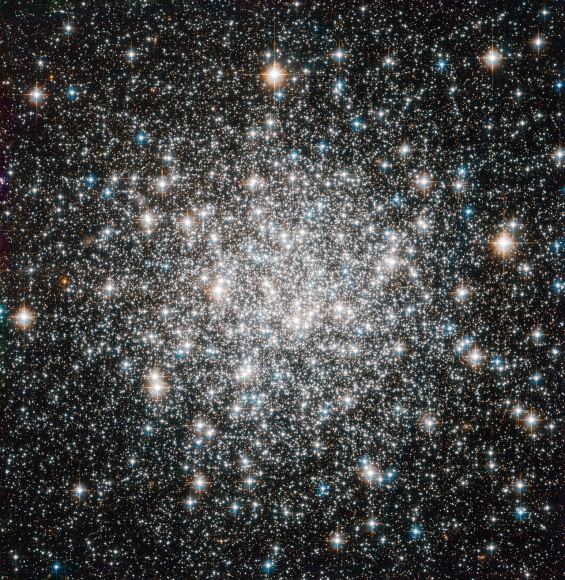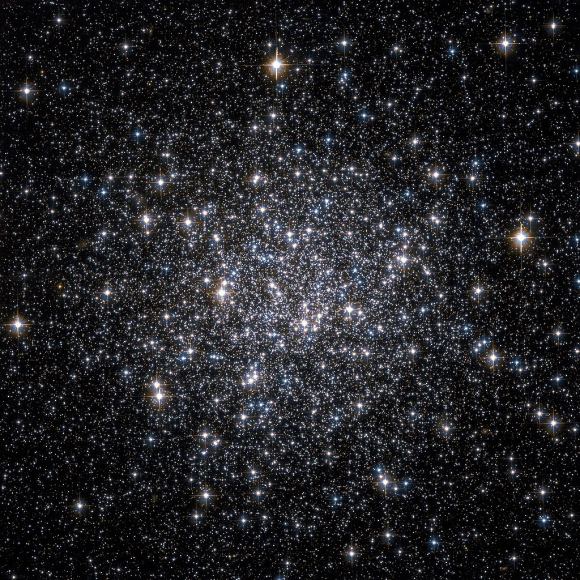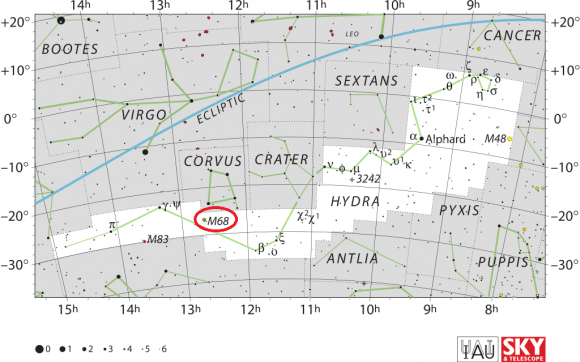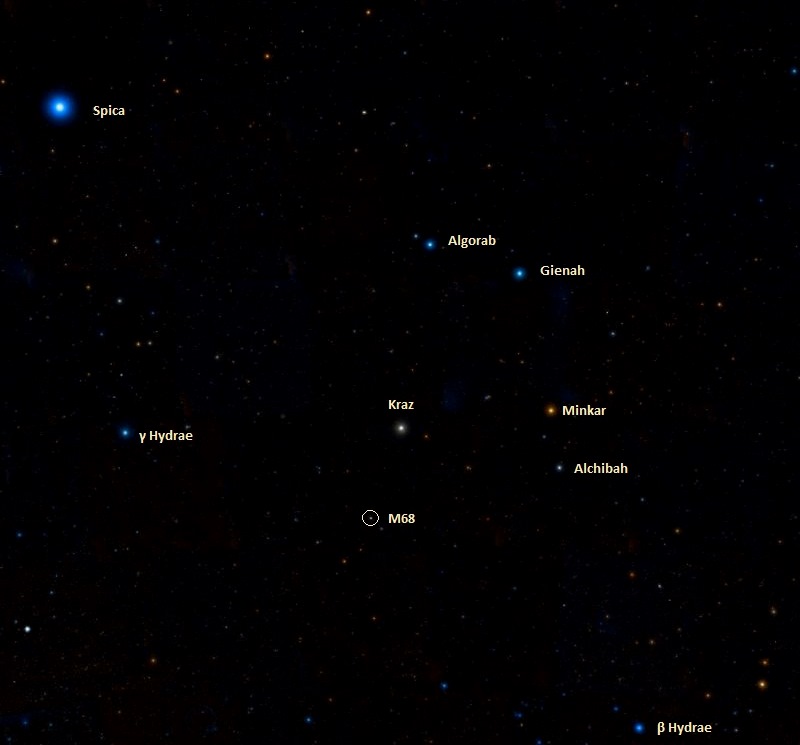Welcome back to Messier Monday! Today, we continue in our tribute to our dear friend, Tammy Plotner, by looking at the globular cluster known as Messier 68.
In the 18th century, while searching the night sky for comets, French astronomer Charles Messier kept noting the presence of fixed, diffuse objects he initially mistook for comets. In time, he would come to compile a list of approximately 100 of these objects, hoping to prevent other astronomers from making the same mistake. This list – known as the Messier Catalog – would go on to become one of the most influential catalogs of Deep Sky Objects.
One of these objects is the globular cluster known as Messier 68. Located roughly 33,000 light-years away in the Constellation of Hydra, this cluster is orbiting through the Milky. In addition to being one of the most metal-poor globular clusters, it may be undergoing core collapse, and is believed to have been acquired from a satellite galaxy that merged with the Milky Way in the past.
Description:
At a distance of approximately 33,000 light-years, the M68 globular cluster contains at least 2,000 stars, including 250 giants and 42 variables – one of which is actually a foreground star and not a true member. Spanning 106 light years in diameter and coming towards us at a speed of 112 kilometers per second, about 250 giant stars are happily perking away – enjoying their chemically abundant status. As Jae-Woo Lee (et al), indicated in a 2005 study:
“We present a detailed chemical abundance study of seven giant stars in M68, including six red giants and one postasymptotic giant branch (AGB) star. We find significant differences in the gravities determined using photometry and those obtained from ionization balance, which suggests that non-LTE (NLTE) affects are important for these low-gravity, metal-poor stars. We adopt an iron abundance using photometric gravities and Fe II lines to minimize those effects, finding [Fe/H] = -2.16 ± 0.02 ( = 0.04). For element-to-iron ratios, we rely on neutral lines versus Fe I and ionized lines versus Fe II (except for [O/Fe]) to also minimize NLTE effects. We find variations in the abundances of sodium among the program stars. However, there is no correlation (or anticorrelation) with the oxygen abundances. Furthermore, the post-AGB star has a normal (low) abundance of sodium. Both of these facts add further support to the idea that the variations seen among some light elements within individual globular clusters arise from primordial variations and not from deep mixing. M68, like M15, shows elevated abundances of silicon compared with other globular clusters and comparable-metallicity field stars. But M68 deviates even more in showing a relative underabundance of titanium. We speculate that in M68 titanium is behaving like an iron-peak element rather than its more commonly observed adherence to enhancements seen in the so-called -elements such as magnesium, silicon, and calcium. We interpret this result as implying that the chemical enrichment seen in M68 may have arisen from contributions from supernovae with somewhat more massive progenitors than those that contribute to abundances normally seen in other globular clusters.”

One of the most unusual features of Messier 68 is its position in the grand scheme of things – opposite our galactic center. We know that globular clusters lay almost exclusively within the galactic halo, so what could cause this? As Yoshiaki Sofue of the University of Tokoyo’s Department of Astronomy explained in a 2008 study:
“We construct a Galacto-Local Group rotation curve, combining the Galactic rotation curve with a diagram, where galacto-centric radial velocities of outer globular clusters and member galaxies of the Local Group are plotted against their galacto-centric distances. In order for the Local Group to be gravitationally bound, an order of magnitude larger mass than those of the Galaxy and M31 is required. This fact suggest that the Local Group contains dark matter filling the space between the Galaxy and M31. We may consider that there are three components of dark matter. First, the galactic dark matter which defines the mass distribution in a galaxy controlling the outer rotation curve; second, extended dark matter filling the entire Local Group having a velocity dispersion as high as ~200 km s^-1, which gravitationally stabilize the Local Group; and finally, uniform dark matter having much higher velocities originating from supergalactic structures. The third component, however, does not significantly affect the structure and dynamics of the present Local Group. We may therefore speculate that at any place in the Galaxy, there are three different components of dark matter having different velocities or different temperatures. They may behave almost independently from each other, but are interacting by their gravity.”
And that fact is carried out by further studies. As Roberto Capuzzo Dolcetta (et al) demonstrated in a study:
“Globular clusters moving in the Milky Way, as well as small galaxies swallowed by the strong tidal field of the Milky Way, develop tidal tails. This project is a part of a larger program of study devoted to the study of the evolution of Globular Cluster Systems in galaxies and of the mutual feedback between the parent galaxy and its GCS, on both the small and large scale. This project is part of an ongoing program devoted to test if and how tidal interaction with the parent galaxy may affect kinematics of stars close to the tidal radius of some galactic globular clusters and explain the flat observed profile of the velocity dispersion radial profile at large radii. The study of the dynamical interaction of globular clusters (hereafter GCs) with the galactic tidal field represents a modern and current astrophysical concern at the light of recent high resolution observations. The globular cluster system (hereafter GCS) results to be less peaked than that of halo stars in our Galaxy, in M31, M87 and M89, as well as in three galaxies of the Fornax cluster and 18 elliptical galaxies. The most probable explanation for this finding is that the two systems (halo and GCS) originally had the same profile and that, afterwards, the GCS evolved due to two complementary effects, mainly: tidal interaction with the galactic field and dynamical friction, which induces massive GCs to decay in the central galactic region in less than 10^8 years. External tidal fields have also the effect of inducing the evolution of the shape of the mass function of individual clusters, because of the preferential loss of low-mass stars as a consequence of mass segregation. Strong evidence that the tidal field plays a fundamental role in the evolution of mass functions was achieved by the discovery that their slopes correlate more strongly with the cluster location in the Milky Way than with the cluster metallicity. But the strongest evidences of the interaction of GCs with the galactic field have been found in the last decade, with the detection of haloes and tails surrounding many GCs.”

Is it true that Messier 68 may indeed by a “left over” from another galaxy? Yes, indeed. As M. Catelan argued in a 2005 study:
“We review and discuss horizontal branch (HB) stars in a broad astrophysical context, including both variable and non-variable stars. A reassessment of the Oosterhoff dichotomy is presented, which provides unprecedented detail regarding its origin and systematics. We show that the Oosterhoff dichotomy and the distribution of globular clusters in the HB morphology metallicity plane both exclude, with high statistical significance, the possibility that the Galactic halo may have formed from the accretion of dwarf galaxies resembling present-day Milky Way satellites such as Fornax, Sagittarius, and the LMC—an argument which, due to its strong reliance on the ancient RR Lyrae stars, is essentially independent of the chemical evolution of these systems after the very earliest epochs in the Galaxy’s history.”
History of Observation:
M68 was discovered by Charles Messier on April 9, 1780 who described it as; “Nebula without stars below Corvus and Hydra; it is very faint, very difficult to see with the refractors; near it is star of sixth magnitude”. The first resolution of the individual stars was, of course, attributed to Sir William Herschel. As he wrote in his notes at the time:
“A beautiful cluster of stars, extremely rich, and so compressed that most of the stars are blended together; it is near 3′ broad and about 4′ long, but chiefly round, and there are very few scattered stars about. This oval cluster is also approaching to the globular form, and the central compression is carried to a high degree. The insulation is likewise so far advanced that it admits of an accurate description of the contour.”
Thanks to a rather strange error on Admiral Smyth’s part, for many years it was believed to be the discovery of Pierre Mechain. As Smyth wrote in his notes:
“A large round nebula on Hydra’s body, under Corvus, discovered in 1780 by Mechain. In 1786, Sir William Herschel’s powerful 20-foot reflector resolved it into a rich cluster of small stars, so compressed that most of the components are blended together. It is about 3′ broad, and 4′ long; and he estimated that its profundity may be of the 344th order. It is posited nearly mid-way between two small stars, one in the np [NW] and the other in the sf [SE] quadrant, a line between which would bisect the nebula. It is very pale, but so mottled that a patient scrutiny leads to the inference, that it has assumed a spherical figure in obedience to attractive forces. Differentiated with Beta Corvi, from which it bears south by east, within 3 deg distance.”
This error took nearly a century to correct! Don’t take a century to view this lovely globular cluster yourself...

Locating Messier 68:
The brighter stars of the northern winter season make finding this small globular cluster quite easy for both binoculars and telescopes – begin first by identifying the lopsided rectangle of the constellation of Corvus and focus your attention on its southeastern most star – Beta. Our target is located about three finger-widths southeast of Beta Corvi and just a breath northeast of the double star A8612.
It will show as a faint, round glow in binoculars, and small telescopes will perceive individual members. Large telescopes will fully resolve this small globular to the core! Messier Object 68 is well suited to any sky conditions when the stars of Corvus are visible.
And here are the quick facts on this Messier Object to help you get started:
Object Name: Messier 68
Alternative Designations: M68, NGC 4590
Object Type: Class X Globular Cluster
Constellation: Hydra
Right Ascension: 12 : 39.5 (h:m)
Declination: -26 : 45 (deg:m)
Distance: 33.3 (kly)
Visual Brightness: 7.8 (mag)
Apparent Dimension: 11.0 (arc min)
We have written many interesting articles about Messier Objects here at Universe Today. Here’s Tammy Plotner’s Introduction to the Messier Objects, M1 – The Crab Nebula, and David Dickison’s articles on the 2013 and 2014 Messier Marathons.
Be to sure to check out our complete Messier Catalog. And for more information, check out the SEDS Messier Database.
Sources:

